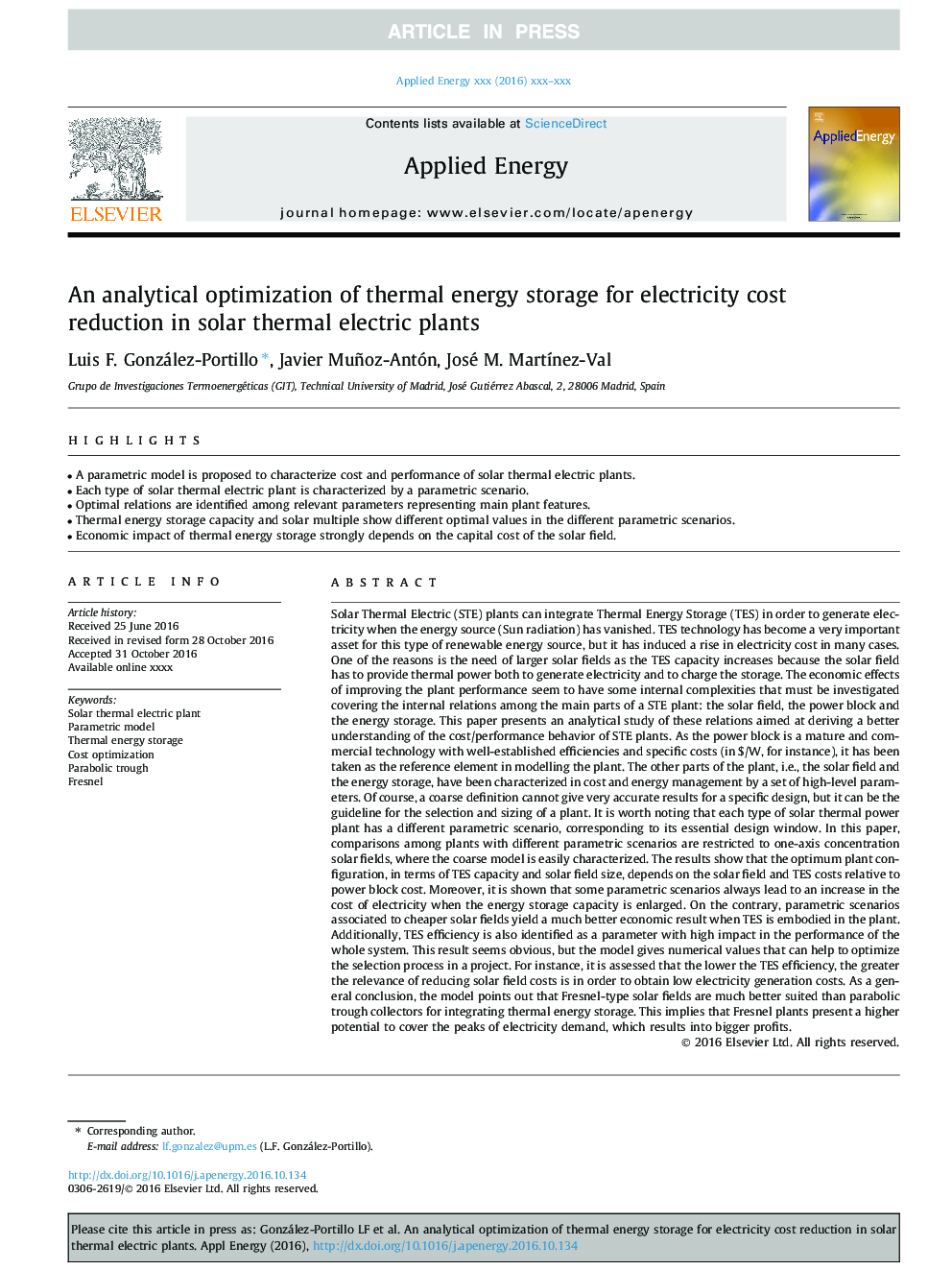| کد مقاله | کد نشریه | سال انتشار | مقاله انگلیسی | نسخه تمام متن |
|---|---|---|---|---|
| 4916993 | 1362738 | 2017 | 16 صفحه PDF | دانلود رایگان |
عنوان انگلیسی مقاله ISI
An analytical optimization of thermal energy storage for electricity cost reduction in solar thermal electric plants
ترجمه فارسی عنوان
بهینه سازی تحلیلی از ذخیره انرژی حرارتی برای کاهش هزینه برق در نیروگاه های حرارتی خورشیدی
دانلود مقاله + سفارش ترجمه
دانلود مقاله ISI انگلیسی
رایگان برای ایرانیان
کلمات کلیدی
نیروگاه حرارتی خورشیدی، مدل پارامتریک ذخیره انرژی حرارتی، بهینه سازی هزینه، کاشت پارابولیک، فرنل،
موضوعات مرتبط
مهندسی و علوم پایه
مهندسی انرژی
مهندسی انرژی و فناوری های برق
چکیده انگلیسی
Solar Thermal Electric (STE) plants can integrate Thermal Energy Storage (TES) in order to generate electricity when the energy source (Sun radiation) has vanished. TES technology has become a very important asset for this type of renewable energy source, but it has induced a rise in electricity cost in many cases. One of the reasons is the need of larger solar fields as the TES capacity increases because the solar field has to provide thermal power both to generate electricity and to charge the storage. The economic effects of improving the plant performance seem to have some internal complexities that must be investigated covering the internal relations among the main parts of a STE plant: the solar field, the power block and the energy storage. This paper presents an analytical study of these relations aimed at deriving a better understanding of the cost/performance behavior of STE plants. As the power block is a mature and commercial technology with well-established efficiencies and specific costs (in $/W, for instance), it has been taken as the reference element in modelling the plant. The other parts of the plant, i.e., the solar field and the energy storage, have been characterized in cost and energy management by a set of high-level parameters. Of course, a coarse definition cannot give very accurate results for a specific design, but it can be the guideline for the selection and sizing of a plant. It is worth noting that each type of solar thermal power plant has a different parametric scenario, corresponding to its essential design window. In this paper, comparisons among plants with different parametric scenarios are restricted to one-axis concentration solar fields, where the coarse model is easily characterized. The results show that the optimum plant configuration, in terms of TES capacity and solar field size, depends on the solar field and TES costs relative to power block cost. Moreover, it is shown that some parametric scenarios always lead to an increase in the cost of electricity when the energy storage capacity is enlarged. On the contrary, parametric scenarios associated to cheaper solar fields yield a much better economic result when TES is embodied in the plant. Additionally, TES efficiency is also identified as a parameter with high impact in the performance of the whole system. This result seems obvious, but the model gives numerical values that can help to optimize the selection process in a project. For instance, it is assessed that the lower the TES efficiency, the greater the relevance of reducing solar field costs is in order to obtain low electricity generation costs. As a general conclusion, the model points out that Fresnel-type solar fields are much better suited than parabolic trough collectors for integrating thermal energy storage. This implies that Fresnel plants present a higher potential to cover the peaks of electricity demand, which results into bigger profits.
ناشر
Database: Elsevier - ScienceDirect (ساینس دایرکت)
Journal: Applied Energy - Volume 185, Part 1, 1 January 2017, Pages 531-546
Journal: Applied Energy - Volume 185, Part 1, 1 January 2017, Pages 531-546
نویسندگان
Luis F. González-Portillo, Javier Muñoz-Antón, José M. MartÃnez-Val,
